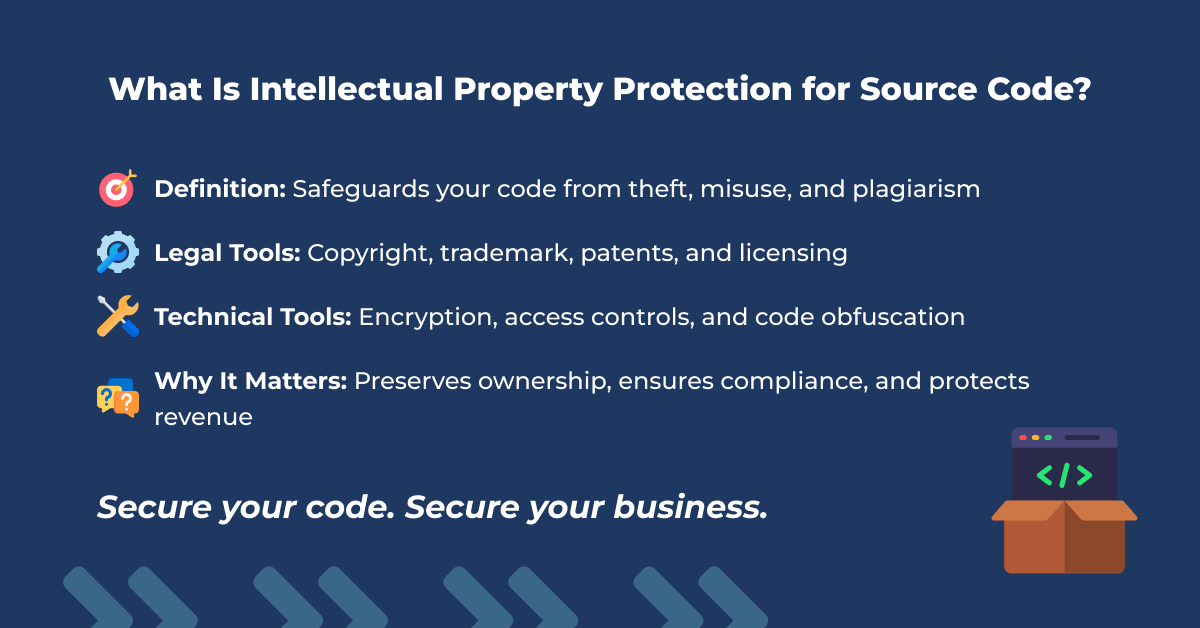 Share Your Requirements
Share Your Requirements
Have you ever found your code reused without permission?
Every line of code you write holds value. It represents hours of effort, strategic thinking, and problem-solving. But in today's fast-paced development environment, source code theft and unauthorized use are real threats. If you're a developer, tech founder, or CTO, understanding how intellectual property protection is no longer optional, it's essential.
Whether you're building proprietary software or managing distributed teams, this guide will help you navigate the basics of IP protection and apply practical safeguards to your source code.
What Is Intellectual Property Protection for Source Code?
Definition: Intellectual Property (IP) Protection for Source Code refers to the legal and technical measures taken to secure ownership, originality, and usage rights of code written by individuals or organizations. It includes copyrights, licenses, contracts (like NDAs), and monitoring tools to prevent unauthorized access or misuse.

Your source code is not just functional—it's intellectual property with commercial value. It can be patented, copyrighted, or licensed, and if unprotected, it's susceptible to:
In fact, a 2024 GitGuardian report revealed that 1 in 10 developers unintentionally leak proprietary code in public repos or shared workspaces.
Explore our expert [Code Review Best Practices] to improve code quality.
Different types of IP rights can apply to source code depending on how you use or distribute your software:
1. Copyright Intellectual Property
2. Patents (in specific cases)
3. Trade Secrets
4. Trademark in Intellectual Property Rights
Many tech startups rely on freelance or outsourced developers during their MVP stage. Without NDAs or IP assignment agreements, these developers may retain rights to the code.
Confused between an NDA and a Contract? Read this!
Case Example: A European fintech startup faced a legal dispute when their former developer reused the backend logic to build a competing app. Lack of IP clauses in their contract made enforcement difficult, costing them users and credibility.
Lesson: Always use contracts that define IP ownership from Day 1.
*See how to get automated code quality assurance with Oodles from day one!
Here's how developers and software businesses can protect their code legally and technically:
Register Copyright
Use Licensing Models
Sign NDAs and IP Assignment Agreements
Implement Source Code Escrow (for B2B software)
Legal protection is one half of the equation. The other is monitoring usage in real-time to detect code theft or leakage.
Consider using:
These tools are especially helpful in distributed or outsourced teams where multiple contributors touch the same codebase.
With the rise of AI coding tools, developers are facing new challenges in IP attribution. Who owns the code generated by an AI? The developer? The platform? Or the AI company?
Best practices:
This area is still maturing, but protecting your originality is key as code generation tools become mainstream.
To summarize, here's a checklist every software team should follow:
- Copyright your commercial code
- Use licensing for internal or open-source distribution
- Sign NDAs and IP transfer clauses for collaborators
- Monitor code usage with tracking tools
- Keep logs of all contributions and commit authors
- Review legal compliance when using AI or third-party code
Watch how Legal Agreements help you in protecting your IP.
Your source code is a business asset. Like trademarks or domain names, it needs to be protected proactively. Whether you're launching a SaaS product, scaling an enterprise solution, or simply writing backend APIs—you must treat your codebase as valuable intellectual property.
By combining legal tools with technical safeguards, you can prevent misuse, build trust, and strengthen your software's long-term viability.
Need expert help with source code IP protection? Our team can guide you in drafting airtight contracts, choosing the right licensing, and implementing secure monitoring tools. Talk to an IP Protection expert today and secure your code before it's too late.
Q1. Can I copyright my source code?
Yes. Copyright applies automatically when you write original code, as it's considered a form of literary work under IP law. However, registering it formally strengthens your legal standing in infringement cases. This registration serves as undeniable proof of authorship and ownership in court.
Q2. What is the difference between copyright and a patent for software?
Copyright protects the expression of your ideas—specifically the syntax, structure, and arrangement of your code. Patents, on the other hand, safeguard unique processes, algorithms, or technical innovations. While patents are harder to obtain, they can offer stronger protection for novel solutions. Both can be used together for layered defense.
Q3. How do NDAs help protect source code?
NDAs, or Non-Disclosure Agreements, legally bind collaborators to confidentiality. They ensure that any code, algorithms, or documentation you share remains private. This is especially important when working with freelancers, vendors, or distributed teams. Without NDAs, you risk exposing valuable code to misuse or theft.
Q4. What is Intellectual Property Tracking Software?
It's a security tool designed to monitor repository activity, code usage, and access logs in real time. These systems can flag suspicious actions, such as bulk copying of files or unauthorized repo access. Many also provide audit trails that can be used as legal evidence in disputes. They are essential for teams managing sensitive or high-value codebases.